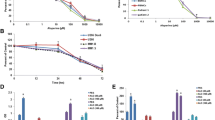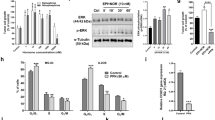Abstract
Purpose
Propranolol, a non-selective β-adrenergic receptor blocker, has been used for the treatment of the patients with hypertension for more than 50 years. There are several in vitro and in vivo evidences that β-adrenergic receptor antagonists inhibit proliferation and angiogenesis and also increase apoptosis in breast, skin, and colon cancers. The aim of this study was to investigate the cytotoxic and apoptotic effects of propranolol and the genes involved in propranolol-induced apoptosis in multiple myeloma cells.
Methods
Time-dependent antiproliferation and apoptotic effects of propranolol were subsequently determined by MTT cell proliferation assay, changes in caspase-3 activity, loss of mitochondrial membrane potential (MMP), and also the localization of phosphatidylserine in the plasma membrane. Changes in expression levels of NF-ΚB pathway were examined by qRT-PCR array.
Results
IC50 values of propranolol on U266 cells were calculated as 141, 100, and 75 μM after 24-, 48-, and 72-h propranolol exposure, respectively. There were significant increases in caspase-3 activity, loss of MMP, and increases in apoptotic cell population in response to propranolol in U266 cells in a time- and dose-dependent manner. There were increases in expression levels of BCL10, TRAF family members, interleukins, TLR1-4, TNFRSF10B, NF-κB, and the inhibitors of NF-κB genes, and significant decreases in expression levels of Bcl-2 in response to propranolol treatment were observed.
Conclusion
These results revealed that propranolol has antiproliferative and apoptotic effects on multiple myeloma cells. Being supported with in vivo analyses, propranolol can be a good and economical way to treat multiple myeloma patients.





Similar content being viewed by others
References
Algazi M, Plu-Bureau G, Flahault A, Dondon MG, Lê MG (2004) Could treatments with beta-blockers be associated with a reduction in cancer risk? Rev Epidemiol Sante Publique 52:53–65
Annabi B, Lachambre MP, Plouffe K, Moumdjian R, Béliveau R (2009) Propranolol adrenergic blockade inhibits human brain endothelial cells tubulogenesis and matrix metalloproteinase-9 secretion. Pharmacol Res 60:438–445
Benish M, Bartal I, Goldfarb Y, Levi B, Avraham R, Raz A, Ben-Eliyahu S (2008) Perioperative use of beta-blockers and COX-2 inhibitors may improve immune competence and reduce the risk of tumor metastasis. Ann Surg Oncol 15:2042–2052
Benjamin B, Hazut O, Shaashua L, Benish M, Zmora N, Barshack I, Hoffman A, Ben-Eliyahu S, Zmora O (2010) Effect of beta blocker combined with COX-2 inhibitor on colonic anastomosis in rats. Int J Colorectal Dis 25:1459–1464
Bradley JR, Pober JS (2001) Tumor necrosis factor receptor-associated factors (TRAFs). Oncogene 20:6482–6491
Buckmiller LM, Munson PD, Dyamenahalli U, Dai Y, Richter GT (2010) Propranolol for infantile hemangiomas: early experience at a tertiary vascular anomalies center. Laryngoscope 120:676–681
Connolly DJ, O’Neill LA (2012) New developments in toll-like receptor targeted therapeutics. Curr Opin Pharmacol. doi:10.1016/j.coph.2012.06.002
Davoodi H, Hashemi SR, Seow HF (2012) Increased NFk-B activity in HCT116 colorectal cancer cell line harboring TLR4 Asp299Gly variant. Iran J Allergy Asthma Immunol 11:121–132
Do KN, Fink LN, Jensen TE, Gautier L, Parlesak A (2012) TLR2 controls intestinal carcinogen detoxication by CYP1A1. PLoS ONE 7:e32309
Du MQ, Isaccson PG (2002) Gastric MALT lymphoma: from aetiology to treatment. Lancet Oncol 3:97–104
Elouni B, Ben Salem C, Zamy M, Sakhri J, Bouraoui K, Biour M (2010) Bortezomib-induced acute pancreatitis. JOP 11:275–276
Emilien G, Maloteaux JM (1998) Current therapeutic uses and potential of beta-adrenoceptor agonists and antagonists. Eur J Clin Pharmacol 53:389–404
Eskdale J, Kube D, Tesch H, Gallagher G (1997) Mapping of the human IL10 gene and further characterization of the 5′ flanking sequence. Immunogenetics 46:120–128
Featherstone HJ (1983) Low-dose propranolol therapy for aborting migraine. West J Med 138:416–417
Frohlich ED (1977) Pathophysiology of propranolol in hypertension. South Med J 70:95–99
Glasner A, Avraham R, Rosenne E, Benish M, Zmora O, Shemer S, Meiboom H, Ben-Eliyahu S (2010) Improving survival rates in two models of spontaneous postoperative metastasis in mice by combined administration of a beta-adrenergic antagonist and a cyclooxygenase-2 inhibitor. J Immunol 184:2449–2457
Kang MR, Kang JS, Yang JW, Kim BG, Kim JA, Jo YN, Lee K, Lee CW, Lee KH, Yun J, Kim HM, Han G, Kang JS, Park SK (2012) Gene expression profiling of KBH-A42, a novel histone deacetylase inhibitor, in human leukemia and bladder cancer cell lines. Oncol Lett 3:113–118
Karnak D, Xu L (2010) Chemosensitization of prostate cancer by modulating Bcl-2 family proteins. Curr Drug Targets 11:699–707
Léauté-Labrèze C, Dumas de la Roque E, Hubiche T, Boralevi F, Thambo JB, Taïeb A (2008) Propranolol for severe hemangiomas of infancy. N Engl J Med 358:2649–2651
Lee TC, Coffey RJ, Currier BM, Ma XP, Canary JJ (1982) Propranolol and thyroidectomy in the treatment of thyrotoxicosis. Ann Surg 195:766–773
Levine B, Sinha S, Kroemer G (2008) Bcl-2 family members: dual regulators of apoptosis and autophagy. Autophagy 4:600–606
Love JN, Sikka N (2004) Are 1–2 tablets dangerous? Beta-blocker exposure in toddlers. J Emerg Med 26:309–314
Mahindra A, Hideshima T, Anderson KC (2010) Multiple myeloma: biology of the disease. Blood Rev 24:5–11
Marquez RT, Xu L (2012) Bcl-2:Beclin 1 complex: multiple, mechanisms regulating autophagy/apoptosis toggle switch. Am J Cancer Res 2:214–221
Masur K, Niggemann B, Zanker KS, Entschladen F (2001) Norepinephrine-induced migration of SW480 colon carcinoma cells is inhibited by beta-blockers. Cancer Res 61:2866–2869
Metry D, Frieden IJ, Hess C, Siegel D, Maheshwari M, Baselga E, Chamlin S, Garzon M, Mancini AJ, Powell J, Drolet BA (2012) Propranolol use in PHACE syndrome with cervical and intracranial arterial anomalies: collective experience in 32 infants. Pediatr Dermatol. doi:10.1111/j.1525-1470.2012.01879.x. http://www.ncbi.nlm.nih.gov/pubmed/22994362
Minnema MC, van der Spek E, van de Donk NW, Lokhorst HM (2010) New developments in the treatment of patients with multiple myeloma. Neth J Med 68:24–32
Park PG, Merryman J, Orloff M, Schuller HM (1995) Beta-adrenergic mitogenic signal transduction in peripheral lung adenocarcinoma: implications for individuals with preexisting chronic lung disease. Cancer Res 55:3504–3508
Richardson PG, Mitsiades C, Schlossman R, Munshi N, Anderson K (2007) New drugs for myeloma. Oncologist 12:664–689
Sans V, de la Roque ED, Berge J, Grenier N, Boralevi F, Mazereeuw-Hautier J et al (2009) Propranolol for severe infantile hemangiomas: follow-up report. Pediatrics 124:423–431
Sarialioglu F, Erbay A, Demir S (2010) Response of infantile hepatic hemangioma to propranolol resistant to high-dose methylprednisolone and interferon-α therapy. Pediatr Blood Cancer 55:1433–1434
Sidbury R (2010) Update on vascular tumors of infancy. Curr Opin Pediatr 22:432–437
Slotkin TA, Zhang J, Dancel R, Garcia SJ, Willis C, Seidler FJ (2000) Beta-adrenoceptor signaling and its control of cell replication in MDA-MB-231 human breast cancer cells. Breast Cancer Res Treat 60:153–166
Sommers Smith SK, Smith DM (2002) Beta blockade induces apoptosis in cultured capillary endothelial cells. In Vitro Cell Dev Biol Anim 38:298–304
Storch CH, Hoeger PH (2010) Propranolol for infantile haemangiomas: insights into the molecular mechanisms of action. Br J Dermatol 163:269–274
Takimoto R, El-Deiry WS (2000) Wild-type p53 transactivates the KILLER/DR5 gene through an intronic sequence-specific DNA-binding site. Oncogene 19:1735–1743
Wajant H, Henkler F, Scheurich P (2001) The TNF-receptor-associated factor family: scaffold molecules for cytokine receptors, kinases and their regulators. Cell Signal 13:389–400
Willis TG, Jadayel DM, Du MQ, Peng H, Perry AR, Abdul-Rauf M, Price H, Karran L, Majekodunmi O, Wlodarska I, Pan L, Crook T, Hamoudi R, Isaacson PG, Dyer MJ (1999) Bcl10 is involved in t(1;14)(p22;q32) of MALT B cell lymphoma and mutated in multiple tumor types. Cell 96:35–45
Yoneda T, Imaizumi K, Maeda M, Yui D, Manabe T, Katayama T, Sato N, Gomi F, Morihara T, Mori Y, Miyoshi K, Hitomi J, Ugawa S, Yamada S, Okabe M, Tohyama M (2000) Regulatory mechanisms of TRAF2-mediated signal transduction by Bcl10, a MALT lymphoma-associated protein. J Biol Chem 275:11114–11120
Zusman R, Christensen D, Federman E, Kochar MS, McCarron D, Porush JG, Spitalewitz S (1987) Comparison of nifedipine and propranolol used in combination with diuretics for the treatment of hypertension. Am J Med 82(3B):37–41. http://www.ncbi.nlm.nih.gov/pubmed/3551602
Acknowledgments
We thank Biotechnology and Bioengineering Center staff of Izmir Institute of Technology for their help and technical support. This study was supported by the Turkish Academy of Sciences Outstanding Young Investigator Programme.
Conflict of interest
We, the authors of the manuscript, do not have any conflict of interest.
Author information
Authors and Affiliations
Corresponding author
Rights and permissions
About this article
Cite this article
Kozanoglu, I., Yandim, M.K., Cincin, Z.B. et al. New indication for therapeutic potential of an old well-known drug (propranolol) for multiple myeloma. J Cancer Res Clin Oncol 139, 327–335 (2013). https://doi.org/10.1007/s00432-012-1331-y
Received:
Accepted:
Published:
Issue Date:
DOI: https://doi.org/10.1007/s00432-012-1331-y




